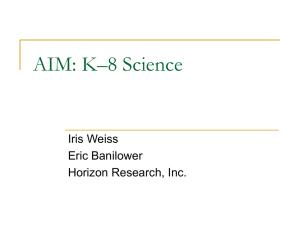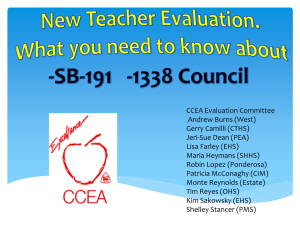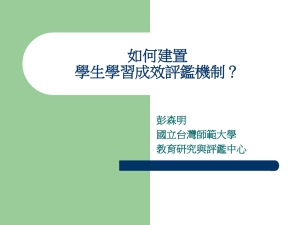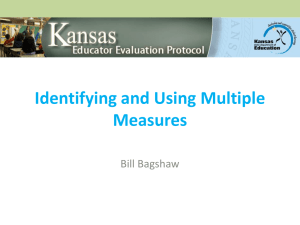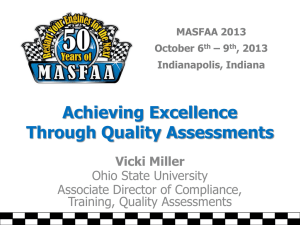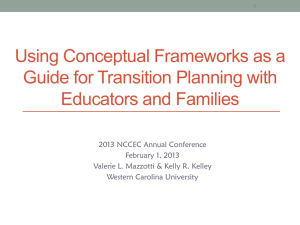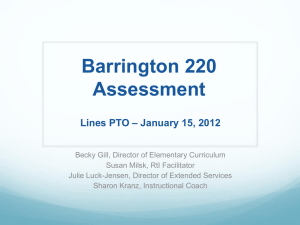Analysis and Reporting for the South Carolina Arts
advertisement
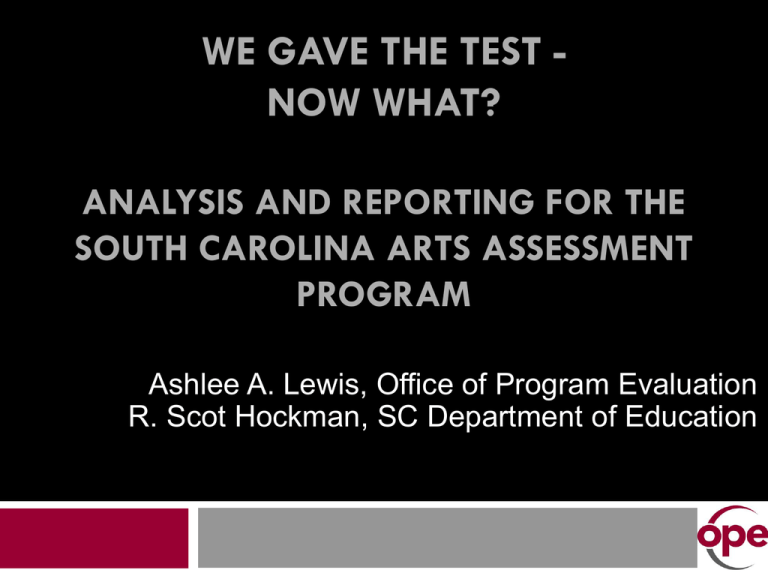
WE GAVE THE TEST NOW WHAT? ANALYSIS AND REPORTING FOR THE SOUTH CAROLINA ARTS ASSESSMENT PROGRAM Ashlee A. Lewis, Office of Program Evaluation R. Scot Hockman, SC Department of Education Intent(s): To demonstrate the process by which the SC Arts Assessment Program moves from test administration to data analysis to reporting results to schools. To talk through the continuous improvement process used for the SCAAP. SOUTH CAROLINA ARTS ASSESSMENT PROGRAM (SCAAP) https://scaap.ed.sc.edu SCAAP Collaborators South Carolina Department of Education (SCDE) Funding Agency Office of Program Evaluation (OPE) at USC Test And Measurement Specialists Logistics South Carolina Arts Educators Content-area Experts Capacity building through statewide arts assessment institutes Current SCAAP Assessments Six different assessments in various stages: Four Entry Level Assessments Music & Visual Arts (pilot tested in 2002) Dance & Theatre (pilot tested in 2005) Two Middle Level Assessments Music & Visual Arts (pilot tested in 2008) Current SCAAP Assessments All assessments… are aligned to SC Academic Standards for Visual & Performing Arts (2010) have two sections Multiple-choice/Selected Response Section (45 items) Performance Task Section (2 tasks) SCAAP Administration Administered each spring to schools that received Distinguished Arts Program (DAP) grants from the SC Department of Education Administered at individual schools by appointed test administrators trained by the SCAAP team Test administrators trained online and in person by the SCAAP team SCAAP Participants 2004—66 schools with approximately 5,200 students 2005—51 schools with approximately 3,700 students 2006—70 schools with approximately 4,900 students 2007—81 schools with approximately 5,800 students 2008—56 schools with approximately 4,400 students 2009 – 46 schools with approximately 3,500 students 2010 – 41 schools with approximately 3,740 students 2011 - 45 schools with approximately 3,540 students 2012 – 32 schools with approximately 2,545 students 2013 – 34 schools with approximately 2,763 students 2014 - 34 schools with approximately 2,572 2015 - 41 schools with approximately 3,700 students (Expected) Music Test Specifications Percent covered by Assessment Format Standard Overall Emphasis Selected Response Performance Tasks Standard 1: Performance 25% - 100% Standard 2: Creating Music 20% 25% 75% Standard 3: Music Literacy 25% 100% - Standard 4: Critical Response to Music 15% 100% - Standard 5: History and Culture 10% 100% - 5% 100% - Standard 6: Connections Visual Arts Test Specifications Percent covered by Assessment Format Standard Overall Emphasis Selected Response Performance Tasks Standard 1: Creating Art 25% 40% 60% Standard 2: Structures and Functions 25% 50% 50% Standard 3: Exploring Content 10% 100% - Standard 4: History and Culture 10% 100% - Standard 5: Interpreting Works of Visual Art 25% 25% 75% 5% 100% - Standard 6: Connections MULTIPLE CHOICE/SELECTED RESPONSE https://scaap.ed.sc.edu The Assessment Process – Achieving the Arts Assessment Mission (Brophy) Modify and Improve Interpret and Evaluate the Data Develop and implement assessments Collect Assessment Data Assessment Improve teaching and learning Establish Goals, and Outcomes The Assessment Process – Achieving the Arts Assessment Mission (Brophy) Modify and Improve Interpret and Evaluate the Data Develop and implement assessments Collect Assessment Data Assessment Improve teaching and learning Establish Goals, and Outcomes SCAAP Item Bank Example Music Item Example Visual Arts Item Analyses Performed Reliability indices for test forms Cronbach’s alpha and corrected split-half index Test form equating Using Item Response Theory (IRT) Cross year and cross form test equating Empirical reliability based on fitted IRT model Differential item functioning (DIF) analysis for gender and ethnicity Distribution of p-values (percent correct) for items Discrimination indices for each item Reliability Estimates Test Music Visual Arts Empirical Reliability Form # of Cronbach’s Corrected Items Alpha Split Half 1 45 0.79 0.79 2 45 0.82 0.82 1 45 0.85 0.86 2 45 0.86 0.85 .83 .86 Item Review Process Convene arts advisors in fall to revise items identified as problematic. Review and revise based on: P-values Discrimination indices Differential Item Functioning (DIF) Distribution of distractors Archive items Write new items to incorporate into test forms Improving the Assessment Each year, item analysis guides the revisions of the assessment for the following year: P-values: Between .20 and .85 Discrimination index: .19 or higher Differential Item Functioning (DIF): All items which receive a C classification are examined. PERFORMANCE TASKS https://scaap.ed.sc.edu Performance Tasks Visual Arts Compare and contrast two artworks using art terms Create a drawing with given art elements/principles based on a prompt Music Sing a familiar song Improvise an 8-beat rhythm pattern using rhythm syllables and maintaining a steady beat Preparing Performance Tasks Receive tasks from schools (flash drives and booklets) Scanning visual arts performance tasks Mass uploading of tasks to website for online rating Performance Task Benchmarking A sampling of responses is chosen and “pre-scored” by members of the SCAAP team based on the rubrics Arts advisors indicate their agreement or dissent with existing scores Discrepancies in scores are discussed and elements of the rubric are clarified Validated, benchmarked tasks are used to train and monitor raters Rater Training Rater trainings have been done online and in person, depending on level of experience Raters review rubrics and anchor items and review rater bias types Interactive practice tests provide feedback on scoring Raters must pass qualifying test before they begin rating Rating System Entire rating system is online Raters must pass a refresher test after scoring 100 tasks Monitoring: Seeds are placed randomly throughout unscored tasks On average, each rater scores 600 tasks over the course of 3 weeks Analyses performed Inter-rater reliability (GENOVA) Both MC and Performance tasks: Correlations between multiple-choice test forms and performance tasks for each area. Inter-rater reliability estimates Music 2013 Performance Task 1 (Singing) 2 (Improvisation) Criteria Generalizability Index of Coefficient Dependability Tonal 0.94 0.94 Rhythm 0.84 0.83 Vocal 0.87 0.87 Rhythm 0.87 0.87 Improvisation 0.79 0.79 Inter-rater reliability estimates Visual Arts 2013 Performance Task Generalizability Coefficient Index of Dependability 1 (Compare and Contrast) 0.88 0.88 2 (Drawing) 0.74 0.74 Annual technical report provided to SC Arts Education Associate and posted online each fall. Full report available at: https://scaap.ed.sc.edu REPORTING https://scaap.ed.sc.edu Report Cards Revisions to report cards made based on teacher feedback Report cards generated in collaboration with programmer Multiple-choice section of report cards generated and disseminated prior to end of school year in May Full report cards including performance tasks results disseminated the following September. Sample Report Card Research on the SCAAP Assessments Comparing the Dimensionality Structures of Music & Visual Arts Multiple-Choice Assessments (SCEPUR, 2006) An Exploratory Study of the Dimensionality Structure of a Music Multiple-Choice Assessment (AERA, 2006) Efficacy of a Web-Based Training and Monitoring Procedure in Scoring Performance Tasks (AERA, 2007) Raters Characteristics and Performance Scores (AERA, 2008) Research on the SCAAP Assessments Rhythm Syllable System and Rhythm Achievement (AERA 2008) The Effect of Gender on a Language-related Theatre Task (SCEPUR, 2009) Teachers’ Use of Assessment Results (AEA, 2010) Teachers Making Meaning of Displays of Student Results (AEA, 2011) Research Using SCAAP Results Comparing Arts Achievement to English Language Arts and Mathematics Achievement in Arts Education Reform Schools (SCEPUR, 2005) Evaluating the Program Characteristics of Arts Schools with Disparate Achievement Levels (SCEPUR, 2006) Multiyear Evaluation of the Arts Education Reform Effort in South Carolina (AERA, 2007) Investigating Arts Programs and Implementation Strategies for Infusing Arts Into Curriculum (AERA, 2007) SCAAP Publications Featured in an assessment textbook: Assessing Performance: Designing, Scoring, and Validating Performance Tasks (Johnson, Penny, & Gordon, 2008) Music Assessment Symposium Proceedings: Assessment in Music Education: Integrating Curriculum, Theory, and Practice (Yap & Pearsall, 2007) Thank you! We welcome your questions! lewisaa2@mailbox.sc.edu shockman@ed.sc.gov

